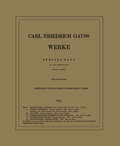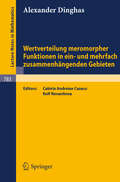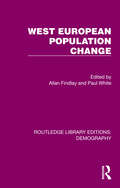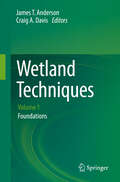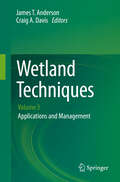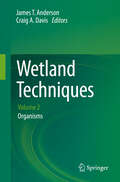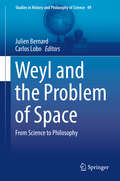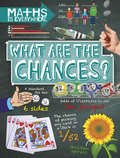- Table View
- List View
The Wellbeing of Nations: Meaning, Motive and Measurement
by Paul Allin David J. HandWhat is national wellbeing and what is progress? Why measure these definitions? Why are measures beyond economic performance needed and how will they be used? How do we measure national wellbeing & turn the definitions into observable quantities? Where are we now and where to next? These questions are asked and answered in this much needed, timely book. The Wellbeing of Nations provides an accessible and comprehensive overview of the measurement of national well-being, examining whether national wellbeing is more than the sum of the wellbeing of everyone in the country, and identifying and reviewing requirements for new measures. It begins with definitions, describes how to operationalize those definitions, and takes a critical look at the uses to which such measures are to be put. The authors examine initiatives from around the world, using the UK ‘measuring national wellbeing programme’ as a case study throughout the book, along with case studies drawn from other countries, as well as discussion of the position in some countries not yet drawn into the national wellbeing scene.
Wellenausbreitung: Grundlagen – Modelle – Messtechnik – Verfahren
by Bernhard RemboldDas Lehrbuch vermittelt dem Leser grundlegende Kenntnisse über das, was zwischen Sende- und Empfangsantenne geschieht, da sie für eine plangemäße Funktion entscheidend sind. Die Wellenausbreitung bestimmt maßgebend die Übertragungsverfahren in der Funkkommunikation und beeinflusst in vielen anderen HF-Anwendungen die Systemauslegung. Ziel des Buches ist, dem Leser diese Kenntnisse zu vermitteln sowie ihn in die Lage zu versetzen, Probleme und Möglichkeiten in Zusammenhang mit der Wellenausbreitung zu verstehen und beurteilen zu können.Die zweite Auflage wurde sorgfältig überarbeitet und teilweise deutlich ergänzt. Weitere Beispiele zur Erläuterung der Theorie wurden eingefügt.
Wellenausbreitung: Grundlagen – Modelle – Messtechnik – Verfahren
by Bernhard RemboldDie Wellenausbreitung bestimmt maßgebend die Übertragungsverfahren in der Funkkommunikation und beeinflusst in vielen anderen HF-Anwendungen die Systemauslegung. Grundlegende Kenntnisse über das, was zwischen Sende- und Empfangsantenne geschieht, sind deshalb für eine plangemäße Funktion entscheidend. Ziel des Buches ist, dem Leser diese Kenntnisse zu vermitteln sowie ihn in die Lage zu versetzen, Probleme und Möglichkeiten in Zusammenhang mit der Wellenausbreitung zu verstehen und beurteilen zu können.
Wellenausbreitung: Grundlagen – Modelle – Messtechnik – Verfahren
by Bernhard RemboldDas Lehrbuch vermittelt dem Leser grundlegende Kenntnisse über das, was zwischen Sende- und Empfangsantenne geschieht, da sie für eine plangemäße Funktion entscheidend sind. Die Wellenausbreitung bestimmt maßgebend die Übertragungsverfahren in der Funkkommunikation und beeinflusst in vielen HF-Anwendungen die Systemauslegung. Ziel des Buches ist, dem Leser diese Kenntnisse zu vermitteln sowie ihn in die Lage zu versetzen, Probleme und Möglichkeiten in Zusammenhang mit der Wellenausbreitung zu verstehen und beurteilen zu können.
Werner Blum und seine Beiträge zum Modellieren im Mathematikunterricht: Festschrift zum 70. Geburtstag von Werner Blum (Realitätsbezüge im Mathematikunterricht)
by Gabriele Kaiser Hans-Wolfgang HennAnlässlich des 70. Geburtstages von Werner Blum wollen wir mit dieser Festschrift seine großen Verdienste für die Mathematikdidaktik würdigen und haben dazu aus der Fülle der von ihm bearbeiteten Themen das Gebiet „Modellieren im Mathematikunterricht“ ausgewählt. Der Band würdigt zum einen in einer breiten Palette von Beiträgen von nationalen und internationalen Expertinnen und Experten aus dem Bereich Modellieren Werner Blums beeindruckende Leistungen in diesem Bereich und seine entscheidenden Impulse zu dessen Weiterentwicklung. Zum anderen gibt der Band in 23 Kapiteln einen Überblick über die aktuelle nationale und internationale Diskussion zum Modellieren im Mathematikunterricht und zeigt auf, welche enormen Fortschritte das Themengebiet in den letzten Jahrzehnten gemacht hat und dass neben theoretischen Arbeiten insbesondere empirische Arbeiten zur Weiterentwicklung des Forschungsgebiets beigetragen haben. Aber auch die Verbreitung von Realitätsbezügen und Modellieren in Schulen wird in den Beiträgen deutlich, zu denen Werner Blum einen entscheidenden Beitrag geliefert hat.
Wertorientiertes Risikomanagement von Versicherungsunternehmen (Masterclass)
by Marcus Kriele Jochen WolfDieses Buch gibt einen methodisch fundierten Zugang zum wertorientierten Risikomanagement, einem fachübergreifenden Aufgabengebiet, das Komponenten aus dem Controlling und dem Aktuariat umfasst. Der anwendungsorientierten Ansatz versetzt den Leser in die Lage, ein auf quantitativen Methoden basiertes Risikomanagement unter kritischer Würdigung seiner Grenzen praktisch im Unternehmen zu implementieren. Die Schwerpunkte des Buches sind hierbei Risikokapital und Kapitalallokation, Erfolgsmessung und wertorientierte Steuerung. Es wird außerdem der Zusammenhang zu regulatorischen Entwicklungen (z. B. Solvency 2) hergestellt. In der Neuauflage wurden die Abschnitte über Solvency 2 vollständig überarbeitet und aktualisiert. Außerdem enthält dieses Buch ausführliche Rechenbeispiele, die in der Open Source Skriptensprache Julia programmiert wurden und aus dem Internet heruntergeladen werden können.
Wertorientiertes Risikomanagement von Versicherungsunternehmen (Masterclass)
by Marcus Kriele Jochen WolfDie Autoren vermitteln Basiswissen für wertorientiertes Risikomanagement – ein ganzheitlicher Ansatz zur Unternehmenssteuerung. Ziel ist es, Leser dazu zu befähigen, ein auf quantitativen Methoden basierendes Risikomanagement im Unternehmen zu implementieren. In ihrer Darstellung verbinden sie mathematische Konzepte mit der Vermittlung praxisrelevanter Methoden. Grundkenntnisse der Wahrscheinlichkeitsrechnung und mathematisches Verständnis werden vorausgesetzt. Der Band enthält Simulationsbeispiele in der frei erhältlichen Statistiksoftware R.
Wertverteilung meromorpher Funktionen in ein- und mehrfach zusammenhängenden Gebieten (Lecture Notes in Mathematics #783)
by A. DinghasWest African Migrations: Transnational and Global Pathways in a New Century
by Moj�b�ol� Ol�f�nk� Okome and Olufemi VaughanDrawing on the interdisciplinary research projects of scholars from various social science and humanities disciplines, this book explores how African migration to Western countries after the neo-liberal economic reforms of the 1980s transformed West African states and their new transnational populations in Western countries.
West European Population Change (Routledge Library Editions: Demography #5)
by Allan FindlayThe 1970s was a decade of significant population change in Western Europe. Originally published in 1986, this book reviews the major trends: fertility decline, counter-urbanisation and the cessation of international labour migration from outside the former EEC. It was the first volume to compare the results of the 1980-82 European census round, and emphasizes the spatial dimension of recent population trends. For countries such as the former West Germany where no census was taken, the difficulties of using registration data are examined. One of the major strengths of the volume is the set of standardised topics which are reviewed by the authors in each country allowing international comparisons to be made from the country case studies. The book concludes with an overview of future trends in European population towards the year 2000.
West European Population Change (Routledge Library Editions: Demography #5)
The 1970s was a decade of significant population change in Western Europe. Originally published in 1986, this book reviews the major trends: fertility decline, counter-urbanisation and the cessation of international labour migration from outside the former EEC. It was the first volume to compare the results of the 1980-82 European census round, and emphasizes the spatial dimension of recent population trends. For countries such as the former West Germany where no census was taken, the difficulties of using registration data are examined. One of the major strengths of the volume is the set of standardised topics which are reviewed by the authors in each country allowing international comparisons to be made from the country case studies. The book concludes with an overview of future trends in European population towards the year 2000.
Wetland Techniques: Volume 1: Foundations
by James T. Anderson and Craig A. DavisWetlands serve many important functions and provide numerous ecological services such as clean water, wildlife habitat, nutrient reduction, and flood control. Wetland science is a relatively young discipline but is a rapidly growing field due to an enhanced understanding of the importance of wetlands and the numerous laws and policies that have been developed to protect these areas. This growth is demonstrated by the creation and growth of the Society of Wetland Scientists which was formed in 1980 and now has a membership of 3,500 people. It is also illustrated by the existence of 2 journals (Wetlands and Wetlands Ecology and Management) devoted entirely to wetlands.To date there has been no practical, comprehensive techniques book centered on wetlands, and written for wetland researchers, students, and managers. This techniques book aims to fill that gap. It is designed to provide an overview of the various methods that have been used or developed by researchers and practitioners to study, monitor, manage, or create wetlands. Including many methods usually found only in the peer-reviewed or gray literature, this 3-volume set fills a major niche for all professionals dealing with wetlands.
Wetland Techniques: Volume 3: Applications and Management
by James T. Anderson and Craig A. DavisWetlands serve many important functions and provide numerous ecological services such as clean water, wildlife habitat, nutrient reduction, and flood control. Wetland science is a relatively young discipline but is a rapidly growing field due to an enhanced understanding of the importance of wetlands and the numerous laws and policies that have been developed to protect these areas. This growth is demonstrated by the creation and growth of the Society of Wetland Scientists which was formed in 1980 and now has a membership of 3,500 people. It is also illustrated by the existence of 2 journals (Wetlands and Wetlands Ecology and Management) devoted entirely to wetlands.To date there has been no practical, comprehensive techniques book centered on wetlands, and written for wetland researchers, students, and managers. This techniques book aims to fill that gap. It is designed to provide an overview of the various methods that have been used or developed by researchers and practitioners to study, monitor, manage, or create wetlands. Including many methods usually found only in the peer-reviewed or gray literature, this 3-volume set fills a major niche for all professionals dealing with wetlands.
Wetland Techniques: Volume 2: Organisms
by James T. Anderson and Craig A. DavisWetlands serve many important functions and provide numerous ecological services such as clean water, wildlife habitat, nutrient reduction, and flood control. Wetland science is a relatively young discipline but is a rapidly growing field due to an enhanced understanding of the importance of wetlands and the numerous laws and policies that have been developed to protect these areas. This growth is demonstrated by the creation and growth of the Society of Wetland Scientists which was formed in 1980 and now has a membership of 3,500 people. It is also illustrated by the existence of 2 journals (Wetlands and Wetlands Ecology and Management) devoted entirely to wetlands.To date there has been no practical, comprehensive techniques book centered on wetlands, and written for wetland researchers, students, and managers. This techniques book aims to fill that gap. It is designed to provide an overview of the various methods that have been used or developed by researchers and practitioners to study, monitor, manage, or create wetlands. Including many methods usually found only in the peer-reviewed or gray literature, this 3-volume set fills a major niche for all professionals dealing with wetlands.
Weyl and the Problem of Space: From Science to Philosophy (Studies in History and Philosophy of Science #49)
by Julien Bernard Carlos LoboThis book investigates Hermann Weyl’s work on the problem of space from the early 1920s onwards. It presents new material and opens the philosophical problem of space anew, crossing the disciplines of mathematics, history of science and philosophy. With a Kantian starting point Weyl asks: among all the infinitely many conceivable metrical spaces, which one applies to the physical world? In agreement with general relativity, Weyl acknowledges that the metric can quantitatively vary with the physical situation. Despite this freedom, Weyl “deduces”, with group-theoretical technicalities, that there is only one “kind” of legitimate metric. This construction was then decisive for the development of gauge theories. Nevertheless, the question of the foundations of the metric of physical theories is only a piece of a wider epistemological problem.Contributing authors mark out the double trajectory that goes through Weyl’s texts, from natural science to philosophy and conversely, always through the mediation of mathematics. Readers may trace the philosophical tradition to which Weyl refers and by which he is inspired (Kant, Husserl, Fichte, Leibniz, Becker etc.), and explore the mathematical tradition (Riemann, Helmholtz, Lie, Klein) that permitted Weyl to elaborate and solve his mathematical problem of space. Furthermore, this volume analyzes the role of the interlocutors with whom Weyl discussed the nature of physical space (Einstein, Cartan, De Sitter, Schrödinger, Eddington). This volume features the work of top specialists and will appeal to postgraduates and scholars in philosophy, the history of science, mathematics, or physics.
Weyl Group Multiple Dirichlet Series: Type A Combinatorial Theory (AM-175)
by Ben Brubaker Daniel Bump Solomon FriedbergWeyl group multiple Dirichlet series are generalizations of the Riemann zeta function. Like the Riemann zeta function, they are Dirichlet series with analytic continuation and functional equations, having applications to analytic number theory. By contrast, these Weyl group multiple Dirichlet series may be functions of several complex variables and their groups of functional equations may be arbitrary finite Weyl groups. Furthermore, their coefficients are multiplicative up to roots of unity, generalizing the notion of Euler products. This book proves foundational results about these series and develops their combinatorics. These interesting functions may be described as Whittaker coefficients of Eisenstein series on metaplectic groups, but this characterization doesn't readily lead to an explicit description of the coefficients. The coefficients may be expressed as sums over Kashiwara crystals, which are combinatorial analogs of characters of irreducible representations of Lie groups. For Cartan Type A, there are two distinguished descriptions, and if these are known to be equal, the analytic properties of the Dirichlet series follow. Proving the equality of the two combinatorial definitions of the Weyl group multiple Dirichlet series requires the comparison of two sums of products of Gauss sums over lattice points in polytopes. Through a series of surprising combinatorial reductions, this is accomplished. The book includes expository material about crystals, deformations of the Weyl character formula, and the Yang-Baxter equation.
Weyl Group Multiple Dirichlet Series: Type A Combinatorial Theory (AM-175)
by Ben Brubaker Daniel Bump Solomon FriedbergWeyl group multiple Dirichlet series are generalizations of the Riemann zeta function. Like the Riemann zeta function, they are Dirichlet series with analytic continuation and functional equations, having applications to analytic number theory. By contrast, these Weyl group multiple Dirichlet series may be functions of several complex variables and their groups of functional equations may be arbitrary finite Weyl groups. Furthermore, their coefficients are multiplicative up to roots of unity, generalizing the notion of Euler products. This book proves foundational results about these series and develops their combinatorics. These interesting functions may be described as Whittaker coefficients of Eisenstein series on metaplectic groups, but this characterization doesn't readily lead to an explicit description of the coefficients. The coefficients may be expressed as sums over Kashiwara crystals, which are combinatorial analogs of characters of irreducible representations of Lie groups. For Cartan Type A, there are two distinguished descriptions, and if these are known to be equal, the analytic properties of the Dirichlet series follow. Proving the equality of the two combinatorial definitions of the Weyl group multiple Dirichlet series requires the comparison of two sums of products of Gauss sums over lattice points in polytopes. Through a series of surprising combinatorial reductions, this is accomplished. The book includes expository material about crystals, deformations of the Weyl character formula, and the Yang-Baxter equation.
The Weyl Operator and its Generalization (Pseudo-Differential Operators)
by Leon CohenThe discovery of quantum mechanics in the years 1925-1930 necessitated the consideration of associating ordinary functions with non-commuting operators. Methods were proposed by Born/Jordan, Kirkwood, and Weyl. Sometime later, Moyal saw the connection between the Weyl rule and the Wigner distribution, which had been proposed by Wigner in 1932 as a way of doing quantum statistical mechanics. The basic idea of associating functions with operators has since been generalized and developed to a high degree. It has found several application fields, including quantum mechanics, pseudo-differential operators, time-frequency analysis, quantum optics, wave propagation, differential equations, image processing, radar, and sonar. This book aims at bringing together the results from the above mentioned fields in a unified manner and showing the reader how the methods have been applied. A wide audience is addressed, particularly students and researchers who want to obtain an up-to-date working knowledge of the field. The mathematics is accessible to the uninitiated reader and is presented in a straightforward manner.
Weyl Transforms (Universitext)
by M.W. WongA study of the functional analytic properties of Weyl transforms as bounded linear operators on $ L2ü(äBbb Rünü) $ in terms of the symbols of the transforms. Further, the boundedness, the compactness, the spectrum and the functional calculus of the Weyl transform are proved in detail, while new results and techniques on the boundedness and compactness of the Weyl transforms in terms of the symbols in $ Lrü(äBbb Rü2nü) $ and in terms of the Wigner transforms of Hermite functions are given. The roles of the Heisenberg group and the symplectic group in the study of the structure of the Weyl transform are explained, and the connections of the Weyl transform with quantization are highlighted throughout the book. Localisation operators, first studied as filters in signal analysis, are shown to be Weyl transforms with symbols expressed in terms of the admissible wavelets of the localisation operators. The results and methods mean this book is of interest to graduates and mathematicians working in Fourier analysis, operator theory, pseudo-differential operators and mathematical physics.
What a Coincidence!: On Unpredictability, Complexity and the Nature of Time
by Bernhard WesslingHow does chance enter our world? And why is so much not predictable?In an understandable, exciting and amusing narrative, the author takes us into the world of chemistry, quantum physics and biology. Touching on astronomy and philosophy, we witness a rewarding journey of discovery. In the process, he develops a completely new view of chance based on the laws of nature. Here, the omnipresent non-equilibrium plays an extremely decisive role, because it generates the complex structures in our world. Finally, on this basis, he presents an equally simple and captivating hypothesis on the nature of time.This non-fiction book provides a deep insight into the fascination of research, the agonizing search for fundamental understanding, and the struggle for scientific knowledge.
What are the Chances?: Probability, statistics, ratios and proportions (Maths is Everywhere #4)
by Rob ColsonWhat are statistics and how are they used? What is the golden ratio? This book explores the maths of probability and statistics and shows how it relates to the everyday world with fantastic appealing visuals.The book is part of the Maths is Everywhere series, which demystifies all aspects of maths and shows how it relates to your everyday world with fun, colourful graphics. These are fantastic books for children aged nine plus who are studying maths, or for anyone who wants to get to grips with maths in a fun way.
What Are the Chances?: Voodoo Deaths, Office Gossip, and Other Adventures in Probability
by Bart K. HollandOur lives are governed by chance. But what, exactly, is chance? In this book, accomplished statistician and storyteller Bart K. Holland takes us on a tour of the world of probability. Weaving together tales from real life—from the spread of the bubonic plague in medieval Europe or the number of Prussian cavalrymen kicked to death by their horses, through IQ test results and deaths by voodoo curse, to why you have to wait in line for rides at Disneyworld—Holland captures the reader's imagination with surprising examples of probability in action, everyday events that can profoundly affect our lives but are controlled by just one number.As Holland explains, even chance events are governed by the laws of probability and follow regular patterns called statistical laws. He shows how such laws are successfully applied, with great benefit, in fields as diverse as the insurance industry, the legal system, medical research, aerospace engineering, and climatology. Whether you have only a distant recollection of high school algebra or use differential equations every day, this book offers examples of the impact of chance that will amuse and astonish.
What are the Chances of That?: How to Think About Uncertainty
by Andrew C. ElliottChance fills every day of our lives and affects every decision we make. Yet, for something woven so closely into the fabric of our being, we are not very good at thinking about uncertainty and risk. In this lively and engaging book, Andrew C. A. Elliott asks why this is so. He picks at the threads and, in showing how our world is built on probability rather than certainty, he identifies five obstacles to thinking about uncertainty that confuse us time after time. Elliott takes us into the casino, but this is not an invitation to gamble. He looks at financial markets, but this is not a guide to investment. There's discussion of health, but this is not a medical book. He touches on genetics and evolution, and music-making, and writing, because chance is at work there too. Entering many different fields, What are the Chances of That? is always following the trail of chance and randomness. One purpose of the book is to go cross-country, to show that there are connected ways of thinking that disrespect boundaries and cut across the domains of finance, and gambling, and genetics, and public health, and creativity. Through it, one visits the vantage points that give a broad view of the landscape and sees how these different areas of life and knowledge are connected - through chance. What are the Chances of That? discusses chance and the importance of understanding how it affects our lives. It goes beyond a mathematical approach to the subject, showing how our thinking about chance and uncertainty has been shaped by history and culture, and only relatively recently by the mathematical theory of probability. In considering how we think about uncertainty, Elliott proposes five “dualities” that encapsulate many of the ambiguities that arise.




